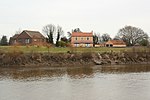Misterton railway station
Disused railway stations in NottinghamshireEast Midlands railway station stubsFormer Great Northern and Great Eastern Joint Railway stationsRailway stations in Great Britain closed in 1961Railway stations in Great Britain opened in 1867 ... and 1 more
Use British English from July 2015
Misterton railway station was a railway station in Misterton, Nottinghamshire, England which is now closed.It was opened by the Great Northern and Great Eastern Joint Railway and closed by British Railways in 1961. Trains between Gainsborough and Doncaster continue to pass through.
Excerpt from the Wikipedia article Misterton railway station (License: CC BY-SA 3.0, Authors).Misterton railway station
Marsh Lane, Bassetlaw
Geographical coordinates (GPS) Address Nearby Places Show on map
Geographical coordinates (GPS)
| Latitude | Longitude |
|---|---|
| N 53.4395 ° | E -0.833 ° |
Address
Marsh Lane
Marsh Lane
DN10 4DL Bassetlaw
England, United Kingdom
Open on Google Maps










